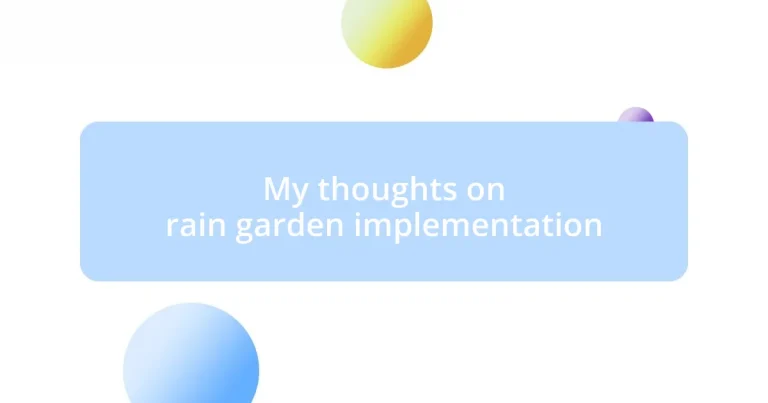Key takeaways:
- Rain gardens absorb and filter rainwater runoff, reducing erosion and improving water quality while promoting biodiversity.
- Key design elements include location, soil type, plant selection, and understanding water dynamics for optimal effectiveness.
- Selecting native plants is crucial as they require less maintenance and thrive in local conditions, creating a resilient ecosystem.
- Regular maintenance, including weeding and watering, ensures the health of the garden and enhances its ecological benefits.
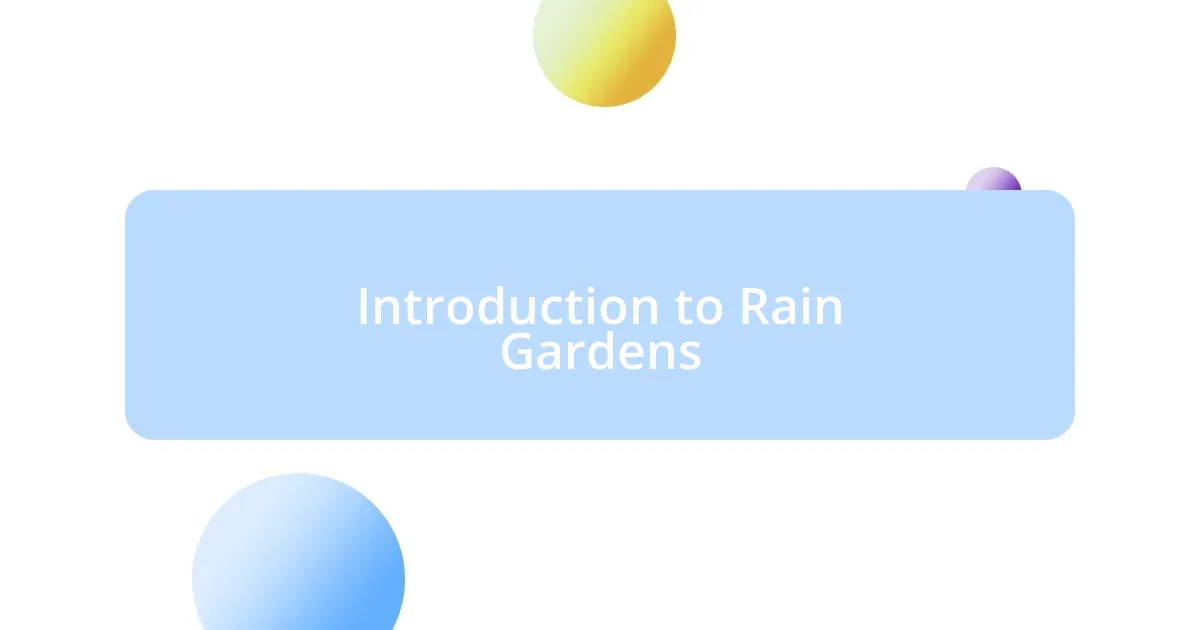
Introduction to Rain Gardens
Rain gardens are more than just a pretty addition to your yard; they serve a vital ecological purpose. As someone who once struggled with excess water pooling in certain areas of my garden, I can personally attest to the transformation a rain garden can provide. These gardens are designed to absorb and filter rainwater runoff, effectively reducing erosion and improving water quality.
Have you ever noticed how rainwater often just runs off hard surfaces, carrying pollutants with it? It’s almost disheartening to think about what we’re allowing to wash into our streams and rivers! By integrating native plants and carefully designed structures, rain gardens act as a natural sponge, soaking up that runoff while also creating a vibrant habitat for local wildlife.
In my experience, creating a rain garden is not just about enhancing the landscape; it’s about fostering a personal connection with the environment. I find joy in watching butterflies flit from flower to flower, knowing that I’ve played a part in supporting their habitat. It’s a rewarding feeling, one that highlights our role in nurturing the earth and promoting biodiversity right in our backyards.
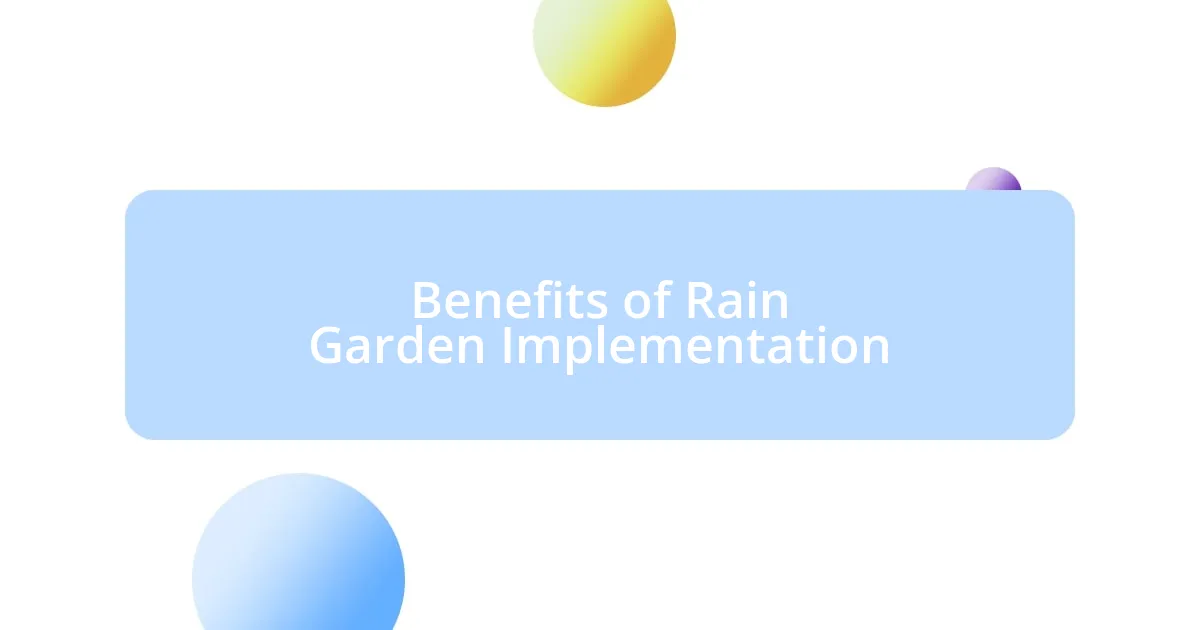
Benefits of Rain Garden Implementation
When implemented, rain gardens can significantly enhance the health of local ecosystems. I’m always amazed by how these gardens not only capture stormwater but also boost biodiversity by providing a habitat for various species. Just last spring, I saw a family of frogs making my rain garden their home, which brought a delightful sense of connection to nature right outside my window.
Another remarkable benefit I’ve noticed is the reduction in flooding during heavy rains. This was particularly evident last year when a sudden downpour threatened my neighborhood. Thanks to my rain garden, the excess water was absorbed, preventing my yard from becoming a soggy mess. I can’t express how satisfying it is to know that my small effort made a big difference in managing stormwater.
Moreover, creating a rain garden can add a splash of beauty to any landscape. I often find myself stepping outside to admire the colorful blooms and the buzzing pollinators that visit. It’s not just about aesthetics; it’s the joy of transforming a previously problematic area into a thriving space that supports both nature and my spirit.
| Benefit | Description |
|---|---|
| Stormwater Management | Rain gardens effectively absorb and manage runoff, reducing the risk of flooding. |
| Biodiversity Enhancement | They provide habitats for wildlife, encouraging biodiversity in urban areas. |
| Aesthetic Appeal | Rain gardens add beauty and vibrancy to landscapes, enhancing property value. |

Key Design Elements to Consider
When planning a rain garden, there are several key design elements that can positively impact its effectiveness and aesthetics. One crucial aspect is the size and shape of the garden itself. In my experience, I found that a well-proportioned space allows for maximum water retention without becoming overwhelming to maintain. I remember when I first designed my garden; I opted for a gentle curve, which not only looked natural but also helped direct water flow more efficiently.
Here are some essential design elements to consider:
- Location: Choose a spot that collects runoff while avoiding proximity to tree roots or structures.
- Soil Type: Opt for well-draining, sandy soils mixed with organic matter to promote infiltration.
- Plant Selection: Use native plants that can thrive in wet and dry conditions, ensuring year-round beauty and pollinator support.
- Depth: Design varying depths within the garden to create microhabitats that cater to a diverse range of species.
- Mulching: Incorporate mulch to help retain moisture and prevent weed growth while adding visual appeal.
Another critical component is understanding the water dynamics in your area. During my initial design phase, I spent time observing how rainwater flowed across my yard. This step was eye-opening; I discovered patterns I hadn’t noticed before, which allowed me to position my garden more effectively. Proper grading and sloping towards the garden can make all the difference. I recall feeling a sense of satisfaction when I noticed how little water pooled in my lawn after heavy rains, all thanks to this thoughtful planning.
- Water Flow: Analyze natural slopes and contours to create a garden that naturally collects runoff.
- Inlets and Outlets: Ensure there are proper entry and exit points for water to flow in and out smoothly.
- Maintenance Access: Design the garden for easy access to allow for straightforward maintenance and planting adjustments.
Taking time to consider these design elements will not only enhance the rain garden’s functionality but also create a unique space that feels like a retreat.

Selecting the Right Plants
When selecting the right plants for your rain garden, I always recommend focusing on native species. Native plants are incredibly resilient; they’ve adapted to local conditions, which means they require less maintenance and are more likely to thrive. I still remember the joy of watching my native lavender bloom after a rainstorm, feeling a sense of pride knowing it flourished in a space that truly suited it.
It’s equally important to consider the plants’ ability to tolerate both wet and dry conditions. I found it fascinating how some of my selected plants, like swamp milkweed, stood tall even during dry spells while soaking up excess water after heavy rains. This versatility not only enhances the beauty of the garden throughout the seasons but also ensures a robust ecosystem that supports various pollinators. Have you ever noticed how bees gravitate toward specific flowers depending on the time of year? It’s a lovely reminder of how interconnected everything is.
Lastly, think about the plant heights and layers. I remember creating a tiered effect with shorter plants in front and taller ones in the back, which resulted in not just a visually appealing design but also a functional habitat for different species. Observing butterflies flit among the blooms adds an extra layer of satisfaction, knowing I’ve created a thriving, dynamic environment right in my backyard. What’s more fulfilling than that?
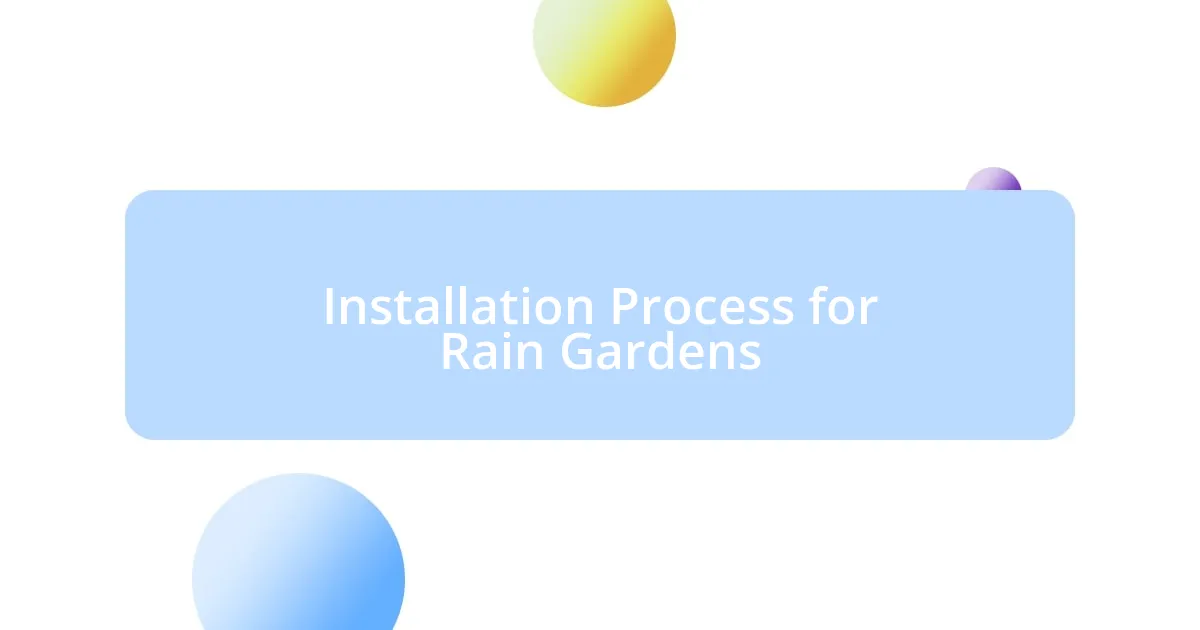
Installation Process for Rain Gardens
When it comes to installing a rain garden, it’s all about careful planning and execution. My first step was to measure out the area, ensuring I allowed enough space while accounting for the local water drainage patterns. I’ll never forget the moment I dug the initial hole; the damp earth beneath my hands felt like nature’s promise that this garden would flourish.
Next, soil preparation plays a crucial role in the success of your rain garden. After deciding on the right mixture, I felt an exhilarating sense of connection to the earth as I amended the soil with compost. The act of turning the soil felt almost therapeutic, and I could already envision the vibrant plant life it would soon support. Have you ever had that moment when you know you’ve laid the foundation for something beautiful? It’s invigorating.
Finally, the planting phase is where the magic really happens. Planting each native species brought me joy as I placed them according to their height and moisture needs, creating a rich tapestry of colors. I took my time, arranging them like pieces of a puzzle, ensuring they’d thrive together. Watching them take root in the following weeks was incredibly rewarding; it felt like nurturing a small ecosystem that I could watch flourish over time. Isn’t it amazing how something as simple as planting can create such an impactful change?
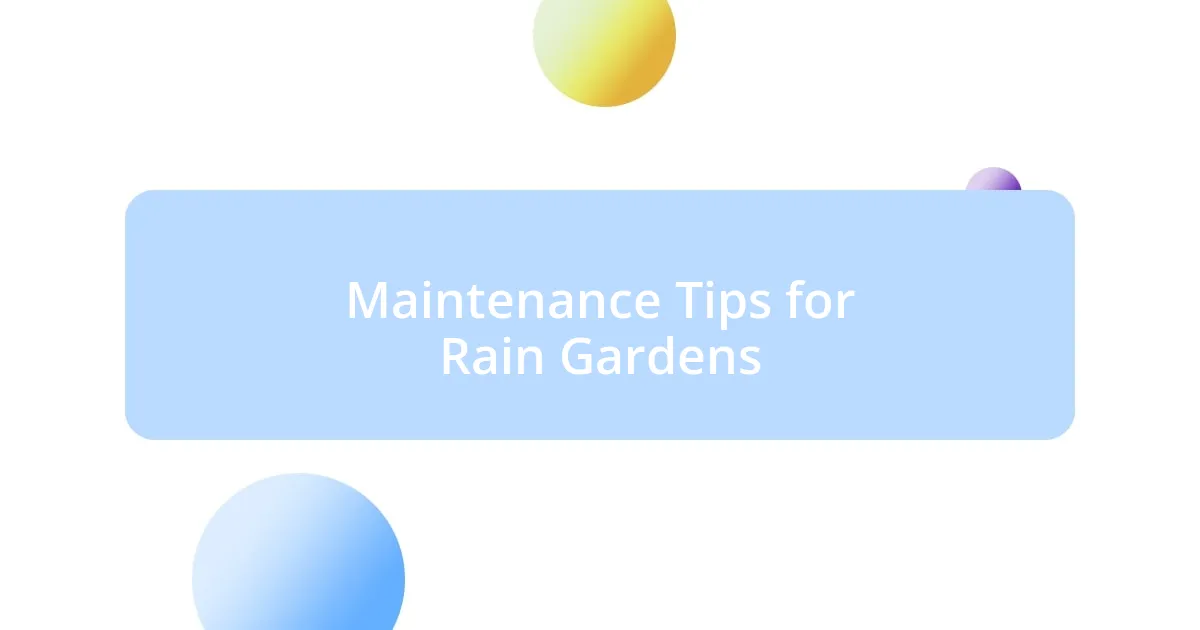
Maintenance Tips for Rain Gardens
Maintaining a rain garden requires a bit of attention, but it’s truly rewarding. I’ve found that regularly checking for weeds keeps the plants healthy and thriving. It’s almost like having a mini-turf war—every time I pull a weed, I feel a sense of victory, knowing I’m not just preserving the garden, but actively nurturing the ecosystem within it. Have you ever felt that satisfaction of winning a small battle in your garden?
Watering is another key aspect, especially during dry spells. I’ve learned that while rain gardens are designed to soak up excess water, they can still benefit from a little human intervention when Mother Nature is feeling stingy. I recall one summer when a long stretch of dry weather left my garden looking a bit parched. A simple watering session brought back luster to my plants, almost as if they were smiling again. Isn’t it incredible how a little water can revitalise life?
Lastly, observing your rain garden regularly can lead to great discoveries. I remember sitting quietly one afternoon, watching the way the wind danced through the foliage. This simple act revealed which plants thrived in certain conditions and allowed me to adapt by introducing new species. It felt like my garden was teaching me lessons about resilience and diversity. How often do we forget to just sit back and appreciate nature’s little wonders unfolding right before our eyes?












